|
@006F.ADF AOX MicroMASTER 486 ADF v1.5 (no VESA video slot)
I006F.ADF Optional Initialization file for @006F.ADF - see inside ADF
@008E.ADF Kingston MC MASTER 486 ADF v2.23 (VESA video slot)
I008E.ADF Initialization file for @008E.ADF
Not sure of these:
@706D.ADF Aox MicroMASTER 486/386 ADF v1.4
I706D.ADF Initialization file for @706D.ADF
@706E.ADF Aox MicroMASTER 4386 ADF v1.04 (damaged...)
MC66PD and MC133PD Installation Guide for MCMaster
MCMaster Utilities
Kingston MCMaster 486
MCMaster 486 MC33PD/0 "REV.D4"
MCMaster 486 MC33PD/8 "REV.?"
MCMaster 486 MC50PD/1 "REV.E2"
Overclocking the 25 MHz to 32 MHz
Supported Memory
Jumper Settings
J801 Function
ADF Sections
Memory Options
MCMaster Errors
Incompatible Systems
Incompatible Adapters
Aox MicroMASTER 486
Super Server
AOX OS/Master
MCMaster Utilities
MCMR236.EXE MCMaster Utility Diskette v2.36
MCM235.EXE MCMaster Utility Diskette v2.35
MC235I.EXE MCMaster Utility Diskette v2.35I
MICROADF.EXE MicroMaster .ADF files
PORT73.EXE displays various info about host system,
installed SIMMs and memory mapping entries.
MMPIDD.SYS is the v1.04 Installable Device Driver (IDD),
required for recognition of the later (Version 2) adapter
IDs. Internal name is MMIDD, as per the earlier v1.03
which appears to have been for the Version 1 adapters.
Specifications
- Uses 5 V 486-class microprocessor
- Daughtercard connector for VESA Local-processor
- Two 72-pin SIMM sockets - IBM or non-IBM SIMMs
- up to 64 MB of onboard memory on 32-bit PS/2 Models
- or 16 MB on 16-bit PS/2 Models
- Internal math coprocessor
- 8 KB internal cache and 128 KB external zero-wait-state cache
- Onboard clock
- Full access to all of the PS/2 computer's Extended Memory
- Support for all PS/2 compatible operating systems
- Supports Micro Channel multi-busmaster capability
All MicroMASTER 486 boards are 32-bit boards.
Kingston MCMaster 486
MCMaster 486 MC33PD/0 "REV.D4"
![Front [P]](/other/img/photo.gif)
![Back [P]](/other/img/photo.gif) (photos by Alex Paterakis)
(photos by Alex Paterakis)
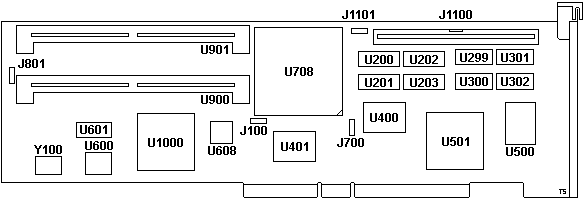
J100 DX/SX select jumper
J700 3-pin jumper
J801 Memory type jumper
J1100 Local Bus Video connector
J1101 3-pin jumper
U200-203 IDT 71589
U299,301 IDT 71B74
U300,302 IDT 7201
U400 AOX DIMM 06210-001
U401 AOX MISC 06215-001
|
U500 Altera U500V48
U501 AOX MMCC 06225-001
U600 AMD AM28F256-150JC
U601 ISSI IS61C64AH-20J
U608 PAL "1338 U608A"
U708 486 CPU socket
U900,901 72-pin SIMM sockets
U1000 AOX MM1000
Y100 33.0000 MHz osc
|
U200-203 IDT 71589 32Kx9 Burst Mode Sync. SRAM
U299,301 IDT 71B74 8Kx8 SRAM Cache-TAG RAM
U300,302 IDT 7201 512x9 AsyncFIFO
IDT 1992/93 High-Performance SRAM Data Book
MCMaster 486 MC33PD/8 "REV.?"
![Front [P]](/other/img/photo.gif)
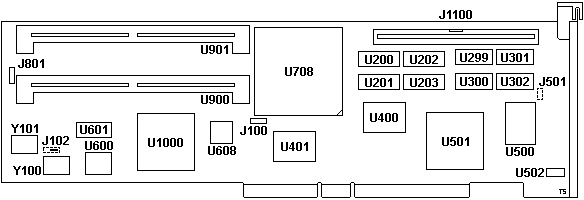
Same as MC33PD/0 "REV.D4" above except for the following items:
J102 pads for clock jumper (1-2 shorted)
J501 pads for 2-pin jumper (open?)
J700,1101 not present
|
U502 74??
Y100 25.0000? MHz osc
Y101 33.0000? MHz osc
|
This version has two oscillators yet the clock select jumper appears to be
soldered in.
MCMaster 486 MC50PD/1 "REV.E2"
![Front [P]](/other/img/photo.gif)
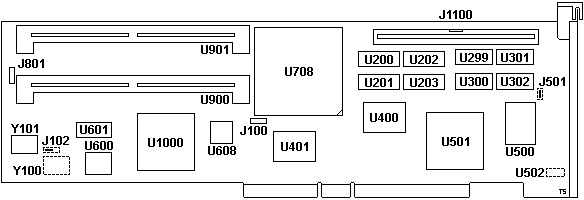
Same as MC33PD/8 "REV.?" above except for the following items:
J102 pads for clock jumper (2-3 shorted)
J501 pads for 2-pin jumper (shorted)
U502 pads for 74??
|
Y100 25.0000 MHz osc
Y101 pads for 33.0000 MHz osc
|
J1100 Local Bus Video
Jeff Marden wrote:
The VESA slot on the Kingston board is indeed for video. An S3
805-based board was designed, but not marketed. While an IDE or SCSI disk
controller is feasible, none has yet been designed.
If you know more about it,
Tell Us!
25 MHz Base Speed
From Dr. Jim:
The 25/33 version should work with a wider range of CPU's. The 25
MHz only version that is modded to be 25/33 seems less than 100% reliable at 33
MHz. The most likely reason is that the ASICs were speed-sorted by the
manufacturer, and ones that didn't pass spec at 33 were tested for use at 25.
The mod is easy to do for us soldering gods, though.
Hacking the 25 MHz MCMaster
Jim Shorney took a 25 MHz adapter and installed a 32 MHz oscillator in Y101
and replaced the hardwired jumper with a jumper block and connected (1-2). The
MCMaster worked with a base rate of 32 MHz and could potentially support one of
the various 5x86-133 upgrade processors. Jim used an oscillator from one of the
newer 8570 planars, as the oscillator physical size and pin configuration does
not match the size and location of the more common larger DIP style
oscillators. (Ed. There are NO holes for mounting a
thru-hole oscillator, SMD only).
Jim found a stable combination for the 25 MHz MCMaster overclocked to 32
MHz. To recap, the machine would lock up over a period of several hours running
Win3.11 and Logstat 5.1 as a test program. This behaviour occurred with an
Intel DX2-66 CPU and an AMD 5x86-133ADZ, and did not appear related to cooling.
The current combination has a Cyrix/IBM Blue Lightning 486-100 CPU with
interposer, and over the past several days, has proven to be stable. It has run
24+ hours without lockup, but must have the planar memory disabled in the
MCMaster setup or it locks up almost immediately."
Supported Memory
MCMaster uses 80 ns or faster FPM, or IBM PD
coded 32-bit wide, 70 ns 72 pin SIMM memory modules.
As per UZnal:
Re the Kingston Upgrade book (1995): "80 ns or faster".
Re the Kingston Upgrade book (1996): KTMxxxxx-70T modules, 70 ns.
| Size |
Speed |
Configuration |
Kingston Part No. |
| 4 MB |
70 ns |
1024K x 32 |
KTM1x32L-70T |
| 8 MB |
70 ns |
2048K x 32 |
KTM2x32L-70T |
| 16 MB |
70 ns |
4096K x 32 |
KTM4x32L-70T |
| 32 MB |
70 ns |
8192K x 32 |
KTM8x32L-70T |
Note: The MCMaster DOES NOT support 1MB or 2MB
SIMM modules.
MCMaster can also function with no onboard memory installed, using only
memory that is already installed in the system. Be aware, however, that running
MCMaster with only off-board memory extracts a performance penalty, especially
in a 16-bit PS/2 system like the model 50 or 60.
Jumper Settings
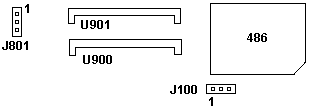
|
| Jumper |
Settings |
Function |
| J100 |
1-2 |
486DX CPU |
| |
2-3 |
486SX CPU |
| J801 |
1-2 |
Non-IBM SIMMs |
| |
2-3 |
IBM SIMMs |
|
Notes:
If only one SIMM is installed, it must be installed in location U900.
If 16 or 32MB SIMMs are used, Jumper J801 is connected to 1 and 2.
Function of J801
William R. Walsh has a flashback and screams:
While diddling around over the weekend with the MCMaster I have
here, I discovered at least one thing the J801 "SIMM Jumper" does. I swapped
out the 2x4MB Kingston 80 ns SIMMs for 2x 4 MB IBM 70 ns SIMMs. Upon rebooting
I found that only 4MB of memory was being seen on the MCMaster. So I changed
the jumper from 1-2 (non IBM SIMMs) to 2-3 (IBM SIMMs) and the memory counted
up correctly afterwards.
Tim Clarke talks him down from the ledge with:
It switches between "PS/2 PD recognition" and "Industry Standard
PD recognition".
MC MASTER ADF v2.23 (AdapterID 008eh)
There is a need for the unusual size of the ADF description. This adapter
can "take over" and has a lot of features that are found in few other adapters.
I have also gone wild on the differing memory options, because people want to
use the planar memory on 8560s or 8580s and don't understand the performance
hits.
;remove semicolon from next line if you wish to use
INITPROG
;initprog 80
Not sure of the function of the following stuff.
;ps2 record IOS:5,IOBNK:1,UNUSEable:1,CDEN:1
;ps3 record INT19:1,ENPROG:1,INTSEL:2,ALVL:4
;ps4 record
UNMAPPED:1,RSRDFLUSH:1,LDD:1,POSCA:1,FLSH:2,N_PARITY:1,AIX:1
;ps5 record
UNUSED5_1:2,ROMSEL:3,ADDMEM:1,MEG16:1,OLDKBD:1
Operating mode
Standard will work in most cases. See
the manual for IDD and INITPROG modes
<Standard>,
INITPROG or IDD, Don't start, Special start
Standard Mode
By default, the MCMaster takes control of the system
immediately after POST (Power On Self Test) is completed
and becomes, for all practical purposes, the main system
CPU.
INITPROG or IDD
The MCMaster can also be set to delay its
startup until it is started by a Track 0 initializer
(INITPROG) or an installable device driver (IDD.) This
is required to accommodate some third-party memory
boards that start with an installable device driver or
an initializer on the system's boot track. Since the
MCMaster.installs its memory at the top of the memory
map (from the host's point of view) a memory board that
is unaware of the MCMaster might conflict with the
MCMaster's memory. With this option set to "INITPROG or
IDD" the MCMaster won't add its memory to the system
total until its device driver or boot track initializer
is loaded.
If the device driver is loaded in the
CONFIG.SYS file after the memory board's driver, or the
boot track initializer comes after the boot track
initializer for the memory board, the MCMaster will be
aware of the third-party memory and install its own
memory above the third-party memory. The
installable device driver is on the MCMaster option
disk. It's called MMPIDD.SYS.
If you use the MCMaster driver, place it
after the driver for the memory board in your CONFIG.SYS
file. For example:
DEVICE = [Memory board driver].SYS
DEVICE = MMPIDD.SYS
IO selects
MC MASTER I/O base address in hex.
The MC MASTER uses a 16 byte I/O block. Under
normal circumstances, select <390>
Helluva lot of choices-
Note: 3b0, 3c0 and
3d0 are normally used for video. Rem out the ";" if you
want to use them.
Arbitration levels
This selects the MCA arbitration level the
MC MASTER will use
<Level_14>
and down to Level_1
Interrupt level
This selects the interrupt level the MC
MASTER uses
<level 15>,
level 10, level 12
Option ROM address
The MCMaster has an option ROM (Read Only
Memory) that contains program code to control the
MCMaster's startup and operation. This entry allows you
to change the address to prevent conflicts with other
adapters' option ROMs. Note that the option ROM only
takes up 16K (16384 bytes) of option ROM space, even
though its base address must be on a 32K boundary.
The "Disable board" option renders the
MCMaster's ROM invisible to the Micro Channel bus: don't
select this option unless instructed to by Kingston
Technical Support for diagnostic purposes.
<D0000 -
D3FFF>, D8000 - DBFFF, C8000 - CBFFF,
Disable ROM
AIX
The AIX operating system does a system
check (INT 15h, Function C0h) at boot time. In a Model
50 or 60, it will "think" that it is in an 80286-based
system, and not boot. Selecting "YES" causes the
MCMaster to return the system ID of a PS/2 Model
80.
<No>,
Yes
Flush Mode
This controls the method that the MCMaster
uses to maintain hardware cache coherency when the
MCMaster is being used with other busmaster adapters
including a number of SCSI disk controllers.
For most installations with no other
busmaster adapters in the system, Mode 1, the default,
will function perfectly well. If another busmaster is
present, select Mode 2. IBM SCSI controllers require
Mode 2. In a small number of cases, if Mode 2 does not
perform correctly, use Mode 3.
<Mode 2>,
Mode 1, Mode 3
Keyboard emulation
The MCMaster incorporates hardware emulation of
the system's keyboard controller.There is a option
to disable this hardware emulation and use the same
software emulation that was used on previous generation
busmaster upgrade products.
If your application experiences
unexpected keyboard behavior, try switching to software
emulation.
<Hardware>,Software
Video Option board
If a Video Option Board is attached to the
MC Master select <enabled>
<disabled>,
enabled
Memory
options
This has no effect if there is no memory on
the MC MASTER.
Note: OS/2 2.0 and
higher is "aware" of the MCMaster and will load itself
into its onboard memory regardless of the memory
configuration.
<Mapped, report
all>
In this configuration, the MCMaster remaps
memory so that, from the MCMaster CPU's point of view,
its own memory appears "first." This means that DOS
applications that run in low memory will be running in
the MCMaster's onboard 32-bit memory. Planar memory, and
any other memory boards, are mapped above the MCMaster's
memory.
The disadvantage of mapping is that
another busmaster adapter in the system sees memory from
the host system's point of view, while the MCMaster has
its own viewpoint. We supply drivers to allow mapping to
work under Windows 3.0/3.1 or OS/2 1.2/1.3 with
busmastering SCSI controllers. Their use is explained in
"Special Drivers for SCSI Adapters."
<Mapped, report all,
<16meg>
This works the same as "Mapped, report all"
except that system memory is limited to 16 MB regardless
of how much memory is physically installed in the
system. This is required in a 32-bit system (e.g. Model
70, 80, 95) with 16-bit adapters installed.
The 16-bit version of the Micro Channel
bus allows only 24 bits of addressing. If a DMA device,
such as the floppy disk controller, attempts to write
past the 16MB boundary, errors can occur due to this
limitation.
<Unmapped>
"Unmapped" mode is just what it says. If
you select "Unmapped," the MCMaster's memory is at the
top of the memory map from its own point of view as well
as from the host point of view, thus eliminating the
need for special drivers..
<Unmapped, <16M>
This works the same as "Unmapped," except
that system memory is limited to 16 Megabytes regardless
of how much memory is physically installed in the
system. This is required in a 32-bit system (e.g. Model
70, 80, 95) with 16-bit adapters installed.
<Report all>
reports all useable memory (planar and MC MASTER) to the
operating system.
<Report MM>
If you select "Report MCMaster memory," any
memory other than the MCMaster's memory is ignored by
both the MCMaster and the host CPU. This combines the
benefits of "Mapped" and "Unmapped" modes. Your
applications are guaranteed to be running in the
MCMaster's 32-bit memory, and the MCMaster's memory
starts at address 0000 from both the MCMaster and the
host point of view...
The disadvantage is that you can't have
any other memory boards in the system. If your system
has only 1 megabyte on the planar, this is not a great
loss. However, if you have a lot invested in Micro
Channel memory boards, you probably want to keep using
them. To use this other memory, you need to select
"Mapped" or "Unmapped."
Note:
In some systems, the MCMaster cannot disable motherboard
memory. If the MCMaster signs on with "Hardware Rev
00.11," you have one of these systems. In this case, the
MCMaster behaves as it would in "Mapped, Report All"
mode except that the MCMaster uses only its own memory.
The host CPU (and any other busmasters) still see system
memory first, followed by MCMaster memory.
<Mapped, report MM, <16meg>
This is not the same as "Report MCMaster
memory." In this mode, planar memory is still visible
from the host point of view, and the same advantages and
disadvantages of "Mapped, report all" apply.
<SS> and <SS16>
are reserved.
MCMaster Errors
MCMaster Error 01: DMA Set to greater than 16Meg
The DMA Controller on the PS/2 Motherboard is limited to 24 bits
of addressing, imposing a 16 Megabyte limit on the address range in which DMA
transfers can take place. If the system tries to do a DMA transfer beyond this
range, data can be corrupted. If this error occurs, reconfigure the system,
selecting one of the "<16M" memory options.
MCMaster Error 02: DMA Set for non-contiguous boundary crossing
This occurs when memory regions that appear contiguous from the
MCMaster's point of view are not contiguous from the bus's point of view. This
is most likely to occur if you attempt to boot OS/2 with the memory option
"Mapped, Report ALL" selected. To fix the problem, select "Report MCMaster" or
"Unmapped."
MCMaster Error 03: Invalid Status
Might indicate a hardware error on the MCMaster. If you see this,
it will also display a group of numbers. Make a note of the numbers, and
contact Kingston Technical Support.
MCMaster Error 04: Bus Timeout
This indicates that an adapter on the Micro Channel bus is holding
the bus too long, causing problems for the MCMaster. If you see this, take note
of what adapters are in the system and contact Kingston Technical Support at
[number redacted].
Incompatible Systems
Some early Model 80 planars do not support
busmastership. Needless to say, this creates problems for
the MCMaster. IBM has issued two different ECA's
(engineering change announcements) ECA #048 and ECA #031,
which cover a specified range of planars.
Systems Affected by Serial Number:
Systems with serial numbers equal to or
below the following MAY have the bad planar
(Ed. My 8580-111 SN#
was included, BUT they had already swapped out the planar
with the up-level 20 MHz one):
| US Systems |
Australian Systems |
Scottish Systems |
| Model |
Serial # |
Model |
Serial # |
Model |
Serial # |
| 8580-111 |
72-6101500 |
8580-121 |
90-3100250 |
8580-M21 |
55-00LFVW0 |
| 8580-121 |
72-9015000 |
8580-321 |
90-3400600 |
8580-X21 |
55-00WMZ45 |
| 8580-311 |
72-6553500 |
|
|
8580-111 |
55-00F6001 |
| 8580-321 |
72-9215500 |
|
|
|
|
Problem Planar FRUs
If the system boards' FRU number (part number) is 90X7390 or
33F8415, or with no FRU number label, then it will have the problem. (The FRU
number is located near the rear edge of the system board near slots 3 and
4.)
Incompatible Adapters
IBM 386 Enhanced Memory Adapter
This adapter comes in two types. One uses a track 0 initializer,
and the other has a ROM. To determine which is which, boot from your Reference
diskette and go to the configuration screen. The adapter with a ROM will be
identified as such in the configuration screen. The adapter with a ROM will
work with the MCMaster without any special attention. To work with the other
type, the MCMaster operating mode will have to be set to "INITPROG or IDD."
Refer to the Appendix A "operating mode" section for details on using either
initprog or installing the IDD, MMPIDD.SYS.
IBM SCSI Adapters
There is an IBM ECA (number 032) on certain SCSI adapters found
primarily in Model 80 25 MHz and Model 95 machines This SCSI controller appears
to be very noise sensitive. If the SCSI adapter is FRU part number
15F6561, it must be replaced with FRU part
number 85F0002.
IBM SCSI Adapters with Cache
If you are using the IBM SCSI adapter with cache and aren't
connecting any external SCSI devices, you may need an external SCSI terminator.
Please refer to the documentation supplied by IBM with the SCSI adapter for
details.
About Third-party Memory Boards
The IBM PS/2 systems feature built-in BIOS support for most IBM
memory boards. Some third-party memory boards use installable device drivers in
the CONFIG.SYS file. You will note in "Appendix A Manual Configuration Options"
that there is a device driver for the MCMaster to work with these memory
boards.
Other memory boards add a small configuration program to the boot track of
your hard drive. Such a program is called a TRACK0 INIT. To support this
feature, IBM has a new version of the Set Configuration program, SC.EXE. If
you've already installed a board that uses this feature, you probably already
have the new SC.EXE. You will find detailed instructions for using it with the
MCMaster under the heading "Operating Mode." If you haven't installed such a
memory board, you don't need to worry about this feature.
Aox MicroMASTER 486 (Card ID 006F)
![Front [P]](/other/img/photo.gif)
![Back [P]](/other/img/photo.gif)
![Detail 1 [P]](/other/img/photo.gif)
![Detail 2 [P]](/other/img/photo.gif) (scan by Jim Shorney)
(scan by Jim Shorney)
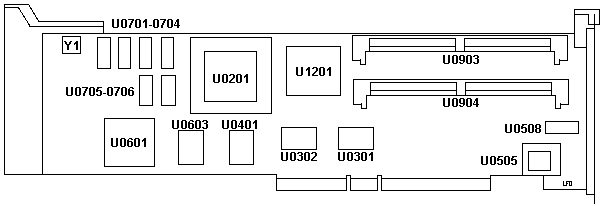
U0201 486 Socket, 5V
U0301,302,603 AOX MM1200 Bus Iface
U0401 AOX MM1100
U0505 Flash ROM
U0508 TC5588J-35 8Kx8 SRAM (Tag?)
U0601 AOX MM1000 Cache Controller
|
U0701-704 TC55328J-25 32Kx8 SRAM
U0705,706 TC5588J-15 8Kx8 SRAM
U0903,904 72-pin SIMM socket
U1201 Plus Logic Memory/DMA Controller
Y1 25.00 MHz osc
|
Note the similarity to the 386 version where the memory SIMMs are to the
right. There is no local video port. The latest Kingston flash BIOS files *do*
work with this card.
Micro Channel "Super Server"
The term "super server" is one that IBM uses to refer to a number of
possible application-specific LAN server configurations. The configurations are
a combination of hardware and software products designed to deliver maximum
performance for PS/2 Micro Channel systems in server applications.
One of these potential solutions that IBM has shown in business shows as a
technology demonstration is based on the PS/2 Model 95 XP 486, combined with
several high-performance bus master adapters and OS/2 operating system
software. It uses an asymmetrical multiprocessor implementation with a unique
function split between the 486 microprocessor of the base system and a second
processor, the AOX MicroMaster 486. The configuration features a huge amount of
both internal and external storage capacity using SCSI bus master adapters, 3.5
inch 320MB disk drives, and the PS/2 3511 external enclosures.
Figure 5.39 illustrates one of the possible IBM "super server"
configurations that was demonstrated as a technology in business shows in 1990.
There were six bus master adapters in the system: two 32-bit SCSI boards, two
16/4 Token Ring adapters, one Ethernet board, and the AOX associate processor.
The software included OS/2 Extended Edition 1.2 and a customized version of
32-bit LAN Server designed to support the two 486 microprocessors.
The SCSI bus masters used SCB architecture to provide chaining of commands.
Up to 16 commands could be chained together and sent to the SCSI adapter for
execution. The adapter also supported scatter-gather operations, which
permitted the data to be scattered anywhere in memory and gathered by the SCSI
adapter into it's cache for execution. This process reduced the overhead
required for data transfers by eliminating a number of steps. The LAN adapters
used are also capable of command-chaining and scatter-gather operations.
In the demonstration, each of the 486 microprocessors in the system had a
copy of OS/2 loaded onto it. The associate processor was responsible for
managing the file system portion of the OS/2 kernel and the LAN requests. The
system board processor ran the Presentation Manager portion and user
applications. The implementation also supported medialess workstations by
loading OS/2 in the memory of the workstation.
In another technology demonstration, another "super server"
configuration connected two servers to the same disk array, illustrating the
ability to recover from a failing disk drive or a failing server. In addition,
a PS/2 Model 95 was configured with four additional 33 MHz 486 processors on
expansion boards to provide even higher levels of performance.
Aox OS/Master
Darius Vaskelis wrote:
As for multi-processing with Aox MicroMASTER adapters, it can be
done. Currently, the only means to do so is with the Aox OS/Master program. It
allows the motherboard CPU to run one operating system, and the CPU on the
MicroMASTER to run another. Commercial applications include running a joint
OS/2 LAN Server/Manager and Novell Netware server, or as mundane as two
isolated DOS machines in one box. OS/Master requires the Aox MicroMASTER
386-33 MHz or the Aox MicroMASTER 486-25 MHz adapter, and does NOT run on the
386-20/25 MHz versions.
|